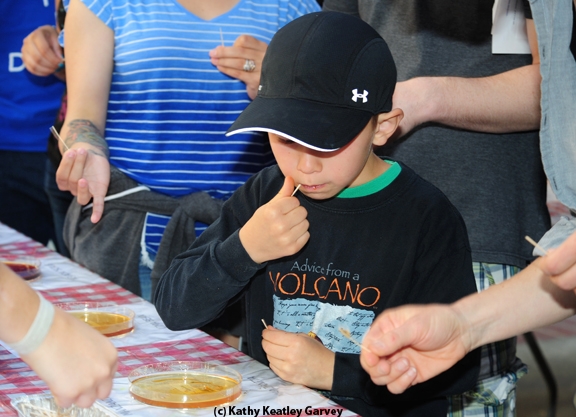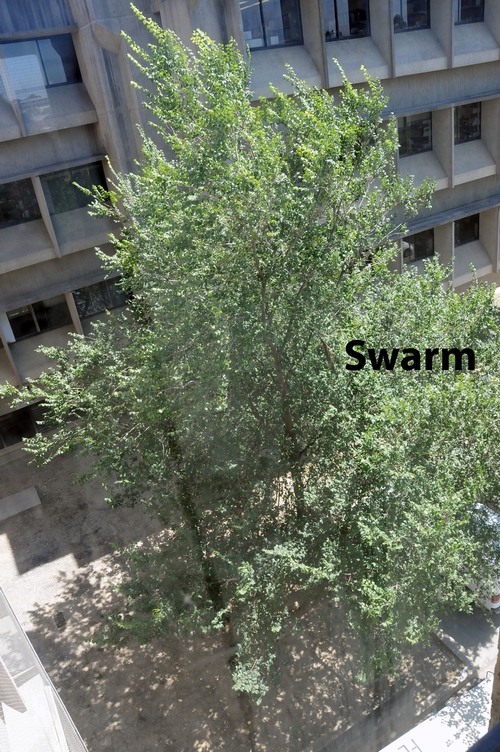- Author: Kathy Keatley Garvey

The Department of Entomology and Nematology will offer honey tasting from 10 a.m. to 3 p.m. in the Briggs Hall courtyard. Last year's event drew some 3000 people. The process is easy: take a toothpick, dip it into the honey container (no double-dipping) and savor.
This year visitors can sample six different varietals of honey: coffee blossom, meadowfoam blossom, buckwheat, creamed clover, cotton and chestnut, according to Extension apiculturist Elina Niño. Across the hallway, in Room 122, folks can check out the bee observation hive from the Harry H. Laidlaw Jr. Honey Bee Research Facility. Niño and staff research associate Billy Synk will answer questions about bees.

Several blocks away, the Honey and Pollination Center, located at the Robert Mondavi Institute for Wine and Food Science (RMI), will offer honey tasting: avocado, orange blossom, sage, sweet pea, meadowfoam and UC Davis wildflower. Visitors can purchase the UC Davis wildflower honey, said Honey and Pollination Center executive director Amina Harris. And yes, there will be a bee observation hive at RMI, too. How fast can you find the queen bee?
Meanwhile, the "Wings of Life" will be playing continuously in the RMI's Sensory Theatre. It doesn't get any better than this!
Harris encourages visitors to "bee all you can bee" by wearing bee or honey costumes or "come dressed as your favorite pollinator." Arts and crafts activities for children are also planned. Think bees. Thank them, too. You'll see bees foraging in the Good Life Garden that fronts RMI. Vegetables, fruits, herbs...they're all there.
Saturday is a also a good time to visit the Häagen-Dazs Honey Bee Haven on Bee Biology Road, west of the central campus. Planted in 2009, the half-acre bee friendly garden is operated by the UC Davis Department of Entomology and Nematology. It is open from dawn to dusk every day for self-guided tours. There you'll see honey bees from the nearby Laidlaw facility doing what they do best--pollinating. Keep a watch out for other pollinators, too. They include sweat bees, digger bees, bumble bees, carpenter bees and butterflies. Then mark your calendar for May 2 to return to the haven from 10 a.m. to 2 p.m. for the fifth anniversary celebration, coordinated by manager Chris Casey.
Yes, Saturday April 18 promises to be a "honey of a day" and a "honey of a picnic."


- Author: Kathy Keatley Garvey

How about almond, yellow starthistle, leatherwood, cultivated buckwheat, safflower and wild oak?
Those are the varieties that will be offered by Extension apiculturist Eric Mussen of the UC Davis Department of Entomology and Nematology at Briggs Hall on Saturday, April 12 during the 100th annual campuswide UC Davis Picnic Day.
Mussen will be offering honey tasting to one and all--come one, come all--from 10 a.m. to 3 p.m. And it's free. You grab a toothpick, poke it in the honey dish, and enjoy.
Folks don't usually like the bitter taste of almond, Mussen says. That's why you won't find it sold in stores. His favorite? Starthistle. It's an invasive weed, but don't tell that to the bees. They love it.
It's also a good time to ask Mussen about honey bees and check out the glassed-in bee observation hive in 122 Briggs. There you can look for the queen (she's the one with a number on her thorax) and watch the colony at work. In addition, the UC Davis Department of Entomology and Nematology is planning scores of educational displays and fun activities. You can learn what an insect is--how it differs from spiders and other critters. You can create maggot art, follow the termite trails and "bet" at the cockroach races. You can learn about forensic, medical, aquatic, apiculture and forest entomology. Like pollinators? Learn about the major pollinators in your backyard. Like fly fishing? Tie a fly.
At the Bohart Museum of Entomology, home of nearly eight million insect specimens, you can see insects have been recently discovered and insects that are threatened and extinct. You can also hold Madagascar hissing cockroaches and walking sticks (live!) in your hand.
All in all, it plans to be a fun day for picnickers who love bugs--or want to learn more about them and what they do.



- Author: Kathy Keatley Garvey
Eagle-eyed Carol Nickles saw it first.
The graduate student coordinator for the UC Davis Department of Entomology spotted the bee swarm from a third-floor window of Briggs Hall.
There it was, swaying on a tree branch, about 25 feet above the ground.
A bee swarm, shaped like a bowling pin, but about 2.5 or 3 feet long.
What exactly is a bee swarm? The late Harry Hyde Laidlaw Jr. (1907-2003), noted bee geneticist-breeder at UC Davis, defined it as "a cluster of worker bees with or without drones and a queen, that has left the hive." The bees often cluster on a tree limb while the "scouts" search for a suitable home.
This particular swarm may be offspring from the bee observation hive located in 122 Briggs Hall for the past several months. Every April the folks at the Harry H. Laidlaw Jr. Honey Bee Research Facility, located west of campus, set up a bee observation hive for UC Davis Picnic Day. Thousands of social folks check out these little social insects. This is a social network more fascinating than Facebook, Twitter, My Space and Linked In combined.
You can watch the colony at work behind glassed walls. You can see the queen laying eggs, the nursemaids caring for the pending offspring, the royal attendants feeding and grooming the queen bee, and the architects and construction workers building the comb. Other bees are processing pollen into bee bread and converting nectar into honey. Meanwhile, workers are returning from their foraging trips and performing their trademark "waggle dances," letting their sisters know where they've been, where to go and how to get there.
As new offspring emerge (21 days for an egg to become an adult), the hive becomes overcrowded and congested. The end result: bee swarms, a natural part of their life cycle and one of nature's wonders.
The bee swarm at Briggs will probably move by tomorrow morning, says UC Davis bee breeder-geneticist Michael "Kim" Fondrk.
"By noon," he estimates, "they'll be gone."


- Author: Kathy Keatley Garvey
If you attend the 95th annual UC Davis Picnic Day on Saturday, April 18 and stop by Briggs Hall between 10 a.m. to 4 p.m., you'll get a taste of honey.
In fact, six tastes of honey.
Extension Apiculturist Eric Mussen, a 32-year member of the UC Davis Department of Entomology faculty, will provide six different flavors of honey: Eastern buckhweat, redwood forest, orange blossom, California sage, Northwest raspberry and Georgia gallberry.
Here's the procedure: you scoop up six toothpicks, one per honey sample. You dip a toothpick into a container of honey (no double-dipping!) and then you discard the toothpick..
The darker honeys are Eastern buckwheat, redwood forest and Georgia gallberry; medium color, Northwest raspberry; and the lighter ones are orange blossom and California sage.
You can almost catch the buzz as you taste the honey. Honey differs in flavor and color, depending on the nectar source (blossoms) that the honey bees visit. Some 300 different varieties of honey are available for sale in the United States. In general, the lighter the color, the milder the flavor.
For more information on honey, visit the National Honey Board's Web site.
Questions about bees? Colony collapse disorder? Bee behavior? Queen bees, worker bees and drones? Why beekeepers wear light-colored clothing and don't eat bananas before visiting the hive? Mussen will be happy to answer them.



- Author: Kathy Keatley Garvey
Friday lite.
That's what it was.
But it was more than that, too.
Every year, Bruce Hammock, distinguished professor of entomology at UC Davis, wages a water balloon battle for faculty, researchers, graduate students, staff, family and friends.
It takes place on the lawn, north side of Briggs Hall, near his basement lab and offices. We like to kid around that he's located on the “garden level” of Briggs. When Hammock hosts Bruce's Big Balloon Battle at Briggs, it becomes the “water level.”
This year (Friday, Aug. 15) they filled 2500 water balloons and then threw them at one another. Every year when the water balloons are all gone, they empty the buckets—which really makes for some nice photos. I'm glad Bruce Hammock can be so accommodating!
“Nobody can beat Bruce Hammock at water balloons,” said former administrative assistant Jeanette Martin, who returned for the big balloon battle.
The Hammock lab works hard and plays hard.
Bruce Dupree Hammock just won the 2008 UC Davis Distinguished Teaching Award for Graduate and Professional Teaching; he was nominated for his "dedication to his students, his interdisciplinary thrust, and his scientific and professional career guidance."
“This award is one of the most prestigious granted on the UC Davis campus and recognizes consistent outstanding teaching and commitment to student success,” said Krishnan Nambiar, chair of the Academic Senate Distinguished Teaching Award Committee in a letter to Hammock nominator Michael Denison, professor of environmental toxicology.
Chemical ecologist Walter Leal, professor of entomology at UC Davis, described Hammock as an excellent teacher and mentor. “I can unequivocally tell you that teaching is Dr. Hammock's passion. He considers teaching the most important role of his university career...He motivates, encourages and inspires, molding a whole new generation of scientists who are discovering ways to benefit humankind.”
Hammock is a member of the National Academy of Sciences and holds a joint appointment in Cancer Research with the UC Davis Medical Center. He directs the National Institute of Environmental Health Sciences (NIEHS) Superfund Program on the UC Davis campus, as well as the National Institutes of Health (NIH) Training Program in Biotechnology, and the NIEHS Combined Analytical Laboratory.
In the last five years Hammock has hosted more than 40 postdoctoral fellows or senior scientists. He has helped train future entomologists, biochemists, engineers, chemists and biologists.
You could say he also trains them to be water warriors.
Make that water warriors, extraordinaire.







